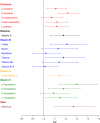Renal cell carcinoma risk associated with lower intake of micronutrients
- PMID: 29968964
- PMCID: PMC6089194
- DOI: 10.1002/cam4.1639
Renal cell carcinoma risk associated with lower intake of micronutrients
Abstract
Kidney cancer incidence in African Americans (AA) is higher than among European Americans (EA); reasons for this disparity are not fully known. Dietary micronutrients may have a protective effect on renal cell carcinoma (RCC) development by inhibiting oxidative DNA damage and tumor growth. We evaluated whether any micronutrient associations differed by race in the US Kidney Cancer Study. 1142 EA and AA RCC cases and 1154 frequency-matched controls were enrolled in a population-based case-control study between 2002 and 2007. Dietary micronutrient intake was derived from an interviewer-administered diet history questionnaire. RCC risk associated with micronutrient intake was estimated using adjusted odds ratios from logistic regression comparing lower to highest quartiles of intake and sample weighting. Inverse associations with RCC risk were observed for α-carotene, β-carotene, lutein zeaxanthin, lycopene, vitamin A, folate, thiamin, vitamin C, α-tocopherol, β-tocopherol, γ-tocopherol, and selenium. A trend for β-cryptoxanthin was suggested among EA but not AA or the total sample (P-interaction = .04). Otherwise, findings did not differ by race, gender, age, or smoking status. The increase in RCC risk associated with lower micronutrient intake is similar within AA and EA populations. A diet rich in sources of micronutrients found in fruits, vegetables, and nuts may help to reduce the overall risk of RCC.
Keywords: African Americans; carcinoma; diet; micronutrients; renal cell; vitamins.
© 2018 The Authors. Cancer Medicine published by John Wiley & Sons Ltd.
Figures

Similar articles
-
Antioxidant micronutrients and the risk of renal cell carcinoma in the Women's Health Initiative cohort.Cancer. 2015 Feb 15;121(4):580-8. doi: 10.1002/cncr.29091. Epub 2014 Oct 9. Cancer. 2015. PMID: 25302685 Free PMC article.
-
Fruit, vegetables, fibre and micronutrients and risk of US renal cell carcinoma.Br J Nutr. 2012 Sep 28;108(6):1077-85. doi: 10.1017/S0007114511006489. Epub 2011 Dec 20. Br J Nutr. 2012. PMID: 22186835
-
Micronutrients and the risk of renal cell cancer: a case-control study from Italy.Int J Cancer. 2007 Feb 15;120(4):892-6. doi: 10.1002/ijc.22374. Int J Cancer. 2007. PMID: 17131347
-
Review of potential risk factors for kidney (renal cell) cancer.Semin Urol Oncol. 2001 Nov;19(4):280-93. Semin Urol Oncol. 2001. PMID: 11769880 Review.
-
The role of diet in renal cell carcinoma incidence: an umbrella review of meta-analyses of observational studies.BMC Med. 2022 Feb 3;20(1):39. doi: 10.1186/s12916-021-02229-5. BMC Med. 2022. PMID: 35109847 Free PMC article.
Cited by
-
Phytochemicals for the Prevention and Treatment of Renal Cell Carcinoma: Preclinical and Clinical Evidence and Molecular Mechanisms.Cancers (Basel). 2022 Jul 4;14(13):3278. doi: 10.3390/cancers14133278. Cancers (Basel). 2022. PMID: 35805049 Free PMC article. Review.
-
Neoplastic Pathogenesis Associated with Cigarette Carcinogens.Cureus. 2019 Jan 25;11(1):e3955. doi: 10.7759/cureus.3955. Cureus. 2019. PMID: 30956908 Free PMC article. Review.
-
An Overview on the Effects of Some Carotenoids on Health: Lutein and Zeaxanthin.Curr Nutr Rep. 2024 Dec;13(4):828-844. doi: 10.1007/s13668-024-00579-z. Epub 2024 Sep 21. Curr Nutr Rep. 2024. PMID: 39304612 Review.
-
Can Diet Prevent Urological Cancers? An Update on Carotenoids as Chemopreventive Agents.Nutrients. 2022 Mar 25;14(7):1367. doi: 10.3390/nu14071367. Nutrients. 2022. PMID: 35405980 Free PMC article. Review.
-
Components of one-carbon metabolism and renal cell carcinoma: a systematic review and meta-analysis.Eur J Nutr. 2020 Dec;59(8):3801-3813. doi: 10.1007/s00394-020-02211-6. Epub 2020 Mar 11. Eur J Nutr. 2020. PMID: 32162043 Free PMC article.
References
Publication types
MeSH terms
Substances
Grants and funding
LinkOut - more resources
Full Text Sources
Other Literature Sources
Medical

